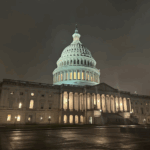
A bipartisan pair of senators on Tuesday reintroduced their bill to require the Department of Homeland Security to increase the percentages of passenger and cargo vehicles being screened by electronic inspection systems entering the U.S. at ports of entry. However, unlike the legislation proposed in 2022, the new version of the Non-Intrusive Inspection Expansion Act (S. 1822) would give the DHS Customs and Border Protection (CBP) agency two more years to obtain the benchmark screening goals. The bill would require…

 By
By 











